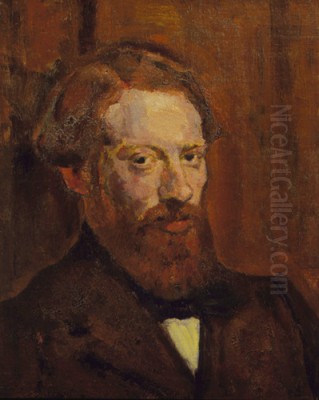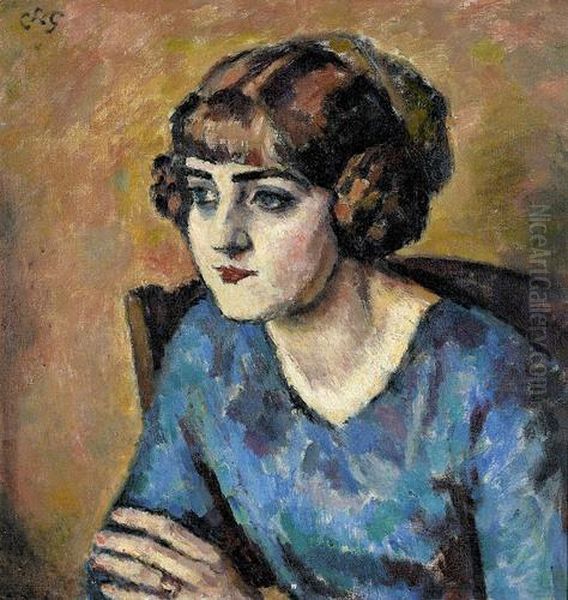
Charles François Prosper Guérin stands as a fascinating figure in French art history, an artist whose career spanned the vibrant transition from the late 19th century into the early decades of the 20th century. Born in Paris in 1875 and passing away in 1939, Guérin navigated a period of intense artistic experimentation and change. He is primarily recognized as a painter, known for his sensitive portrayals, particularly of women, and his nuanced use of color, which evolved throughout his career. His work forms a unique link between the Symbolist traditions he inherited from his education and the burgeoning Post-Impressionist sensibilities that reshaped European art.
Formative Years: Under Moreau's Wing
Guérin's artistic journey began formally at the prestigious École des Beaux-Arts in Paris, the epicenter of academic art training in France. Crucially, he became a student of Gustave Moreau (1826-1898), a leading figure of the Symbolist movement. Moreau's studio was renowned not just for its master's distinctive style, emphasizing mythological and biblical scenes laden with symbolism and rich, jewel-like color, but also for fostering a generation of artists who would go on to define modern art.
Studying under Moreau provided Guérin with a solid foundation in technique but also exposed him to an artistic philosophy that valued imagination, emotion, and subjective experience over strict realism. Moreau encouraged his students to find their own paths, and his atelier became a crucible for diverse talents. Among Guérin's fellow students were artists who would achieve immense fame, such as Henri Matisse (1869-1954) and Georges Rouault (1871-1958), as well as other significant figures like Albert Marquet (1875-1947). This environment undoubtedly shaped Guérin's early development, instilling in him an appreciation for expressive potential and rich surfaces, even as he forged his own distinct artistic identity.
Developing a Personal Style

While rooted in the Symbolist milieu of Moreau's studio, Guérin's style evolved, absorbing and reacting to the diverse artistic currents of his time. He did not fully embrace the radical color experiments of Fauvism, pioneered by his former classmate Matisse, nor did he venture into the structural deconstructions of Cubism being developed by Pablo Picasso (1881-1973) and Georges Braque (1882-1963). Instead, Guérin carved out a more subtle path, blending elements of realism and romanticism with a distinctly modern sensibility.
His work is often characterized by a "delicate sensibility," particularly evident in his earlier pieces. There's a literary quality to some of his compositions, suggesting narratives or moods drawn from internal states rather than purely objective observation. This aligns with the broader Post-Impressionist interest in conveying emotion and subjective viewpoints, moving beyond the Impressionists' focus on capturing fleeting moments of light and atmosphere, as seen in the work of Claude Monet (1840-1926) or Camille Pissarro (1830-1903).
A significant influence on Guérin's artistic development was Paul Cézanne (1839-1906). While Guérin did not adopt Cézanne's rigorous analysis of form and structure wholesale, the elder master's emphasis on building form through color and his departure from traditional perspective likely informed Guérin's own explorations in composition and palette. Guérin managed to integrate these modern influences while retaining a personal touch, marked by elegance and sensitivity.
Color and Light: A Painter's Exploration
Color was a central element in Charles Guérin's art, and his approach to it evolved significantly. His earlier works often feature more subdued, nuanced palettes, reflecting perhaps the Symbolist influence and a focus on mood and atmosphere. He demonstrated a fine control over tonal harmonies, creating intimate and often introspective scenes through subtle gradations of color.
As his career progressed, particularly into the early 20th century, Guérin's use of color became bolder and more assertive, though generally remaining balanced and harmonious. He employed color not just descriptively but expressively, allowing it to contribute significantly to the emotional weight of his paintings. This aligns with the broader Post-Impressionist exploration of color's autonomous expressive power, seen in the works of artists like Paul Gauguin (1848-1903) or Vincent van Gogh (1853-1890), although Guérin's application was typically less intense and more controlled.
His skill lay in creating visually appealing compositions through carefully considered color relationships, often using a relatively simple palette enhanced by specific accent colors. This mastery allowed him to capture the play of light effectively and to imbue his subjects, whether figures or the occasional landscape, with vibrancy and life.
The Female Form: A Central Motif
Throughout his oeuvre, the depiction of women remained a consistent and central theme for Charles Guérin. He excelled at portraiture and genre scenes featuring female figures, capturing them in moments of quiet contemplation, domestic intimacy, or poised elegance. His approach differed from the sometimes detached observation of Edgar Degas (1834-1917); Guérin often seemed more invested in conveying the inner state or mood of his subjects.
His female portraits, such as the known Porträt einer Dame (Portrait of a Lady) or a specific Female Portrait dated 1906 (recorded as measuring 55 x 46 cm), exemplify his skill in this area. These works showcase his ability to combine technical proficiency in rendering form and fabric with a subtle psychological insight. The figures are often presented with a gentle grace, their expressions hinting at complex emotions beneath a calm exterior.
This focus on intimate, often interior scenes featuring women connects Guérin to the Nabis painters, such as Pierre Bonnard (1867-1947) and Édouard Vuillard (1868-1940), who also explored the decorative possibilities and emotional resonance of domestic spaces and the figures within them. Guérin's treatment, however, often retained a more classical sense of form compared to the flatter, more patterned surfaces favored by some Nabis artists. His sensitive portrayal of women, avoiding overt sentimentality while still conveying warmth and personality, remains one of the most recognizable aspects of his work.
Other Subjects and Media
While best known for his paintings of women, Guérin's artistic output included other subjects. The title Vieux de Saint Nicolas (Old Saint Nicolas Street) suggests an interest in urban scenes or landscapes, capturing the character of specific locations. Like many artists of his time, he likely explored various genres to hone his skills and express different facets of his artistic vision.
The available information also indicates that Guérin engaged in other artistic activities beyond painting, including illustration and printmaking. This diversification was common among artists of the period, allowing them to reach wider audiences and explore different expressive possibilities offered by various media. His involvement in illustration suggests a connection to the literary world, perhaps reinforcing the "literary" quality noted in some of his painted works. Printmaking, whether etching, lithography, or other techniques, would have offered another avenue for exploring line, tone, and composition.
However, his reputation rests primarily on his achievements as a painter. His dedication to the medium, particularly oil on canvas, allowed him to fully develop his characteristic style, marked by its sensitive handling of paint, nuanced color, and focus on evocative figure studies.
Navigating the Art World: Salons and Exhibitions
Charles Guérin actively participated in the Parisian art scene, exhibiting his work in important venues that showcased the evolving trends of modern art. He was present at the Salon d'Automne (Autumn Salon) starting around 1903 and the Salon des Indépendants (Salon of Independents) by 1906. These Salons were crucial alternatives to the more conservative official Salon des Artistes Français, providing platforms for artists experimenting with new styles, including the Post-Impressionists and the Fauves.
His participation in these exhibitions placed him alongside many of the leading avant-garde artists of the day, demonstrating his engagement with the contemporary art discourse. Furthermore, Guérin achieved recognition in international expositions, which were major cultural events at the turn of the century. He received an Honorable Mention at the Paris Exposition Universelle (World's Fair) of 1900, a significant acknowledgment early in his career.
Later, he was awarded a Silver Medal at the Louisiana Purchase Exposition held in St. Louis, Missouri, in 1904. These awards indicate that his work was well-received not only within the progressive circles of the independent Salons but also by international juries assessing contemporary art from around the world. This success highlights his ability to create art that resonated both with modernist sensibilities and broader appreciative audiences.
Context: Post-Impressionism and Beyond
Placing Charles François Prosper Guérin within the complex tapestry of early 20th-century art requires understanding his unique position. He was deeply influenced by his Symbolist training under Moreau and clearly absorbed lessons from the Post-Impressionist master Cézanne. Yet, he charted a course distinct from the major movements that followed. He was not a Fauve, despite his connections to Matisse and Marquet. His work lacked the explosive, arbitrary color and distorted forms associated with Fauvism.
Similarly, he remained distant from the analytical deconstruction of Cubism. His art remained fundamentally representational, focused on capturing the essence of his subjects through nuanced observation and painterly technique. His style might be seen as aligning more closely with a strand of Post-Impressionism that emphasized sensitivity, intimacy, and the expressive qualities of color and light, without radically breaking from figurative traditions.
In this sense, his work shares affinities with artists sometimes termed "Intimists," like Bonnard and Vuillard, although Guérin often maintained a more solid, less dissolved sense of form. He can also be considered alongside other contemporaries who navigated the space between tradition and modernity, such as Henri Lebasque (1865-1937) or perhaps even certain aspects of the work of Odilon Redon (1840-1916), another artist linked to Symbolism but with a highly personal vision. Guérin represents a quieter, more lyrical voice within the vibrant artistic dialogues of his era.
Legacy and Art Historical Position
In the grand narrative of art history, Charles François Prosper Guérin is perhaps not counted among the revolutionary figures who drastically altered the course of Western art, like Cézanne, Picasso, or Matisse. However, his contribution remains significant as a talented and sensitive painter who skillfully navigated the transition from 19th-century traditions to 20th-century modernism.
His legacy lies in his ability to synthesize influences – the imaginative depth of Symbolism, the structural awareness gleaned from Cézanne, and a personal sensitivity towards his subjects, especially women. He produced a body of work characterized by technical skill, refined color sense, and emotional resonance. His paintings offer a window into the more intimate and lyrical side of Post-Impressionism, a counterpoint to the era's more radical experiments.
The continued interest in his work, evidenced by pieces appearing at auction (like the 1906 Female Portrait estimated at $4,000-$7,000 in a past sale), indicates that his art retains value and appreciation. He stands as an important representative of that generation of artists who absorbed the lessons of Impressionism and Symbolism and forged personal styles that contributed to the rich diversity of French painting in the early modern period. He was a bridge figure, connecting the sensibilities of the past with the emerging concerns of a new century.
Conclusion
Charles François Prosper Guérin (1875-1939) was a distinguished French painter whose career unfolded during a pivotal moment in art history. A student of Gustave Moreau, he absorbed the tenets of Symbolism but developed a personal style marked by a delicate sensibility, a nuanced understanding of color influenced by Post-Impressionism, particularly Cézanne, and a profound affinity for depicting the female form with grace and psychological depth. While not a radical innovator on the scale of some contemporaries like Matisse or Picasso, Guérin created a significant body of work characterized by its technical refinement, emotional subtlety, and harmonious compositions. Exhibiting at key Salons and international expositions, he gained recognition for his distinct artistic voice. His paintings endure as testaments to a lyrical and sensitive approach to modernism, securing his place as a valuable contributor to the artistic landscape of early 20th-century France.